Utah ranks 9th in the nation when it comes to solar power generation — and 5th in residential solar installations. Solar panels in Salt Lake City are becoming even more popular as the local government is planning more programs to encourage residents to install them. In fact, an entire community in Herriman will be wholly solar-powered. Utah’s unique topography demands carbon-free energy sources and advances in technology are making it possible.
Moving Away from Coal
Currently, more than 80 percent of Utah’s energy production comes from fossil fuels. Concern over declining air quality — especially during winter inversions have prompted the local government to encourage the use of alternative energy sources. Rocky Mountain Power, the state’s electricity provider, is planning to shut down 20 of its 24 coal-fired power plants by 2038, as the state aims to be carbon neutral by 2040. The power company now manages the solar production and storage of an entire community in Herriman, and more are planned if the project proves successful.
The use of coal is partly to blame for Utah’s air pollution problem — made worse by the winter inversions. The state is advocating for clean energy and its power suppliers are moving to solar energy. Solar power constitutes half of Utah’s renewable energy production — but the local government aims for it to consist of the majority of total power production by 2040.
Solar-Powered Homes
Utah has one of the cheapest electricity costs (10th) in the nation, but residents are still opting for solar-powered homes. The state ranks 5th in residential solar installations — behind Hawaii, California, Arizona, and Rhode Island. Three of the four states have electricity costs at almost double that of Utah, with only Arizona having comparable rates. High cost of electricity is usually the primary reason for opting for solar power, but Utahns have different motivations. The majority of households opting for solar power hold environment-friendly stances.
Solar energy systems are good investments that usually pay for themselves in 10 years. Panels are becoming more efficient and durable, often lasting 30-40 years before declining in performance. About 10 percent of the state’s solar energy production comes from residential/independent producers — reducing the demand on the coal-powered grid.
Solving the Nighttime Dilemma
The only major issue with solar power is its reliability. The sun only appears for half the time and your nighttime electrical consumption will still need to rely on the grid. However, advances in technology have made storing excess energy for later use possible. Rocky Mountain Power’s Herriman community is equipped with electrical storage batteries in each home — allowing houses to rely solely on electricity derived from the sun 24 hours a day. Several companies have also joined the race for affordable electrical storage solutions, and Utah is becoming a battleground to test their discoveries and innovations.
Make the Solar Investment

Air pollution is a serious issue for most Utah residents and solar power is one of the most viable solutions. Advances in technology are not only making it a cost-effective option — it is making solar power a sound investment that pays for itself 3-4 times over.

